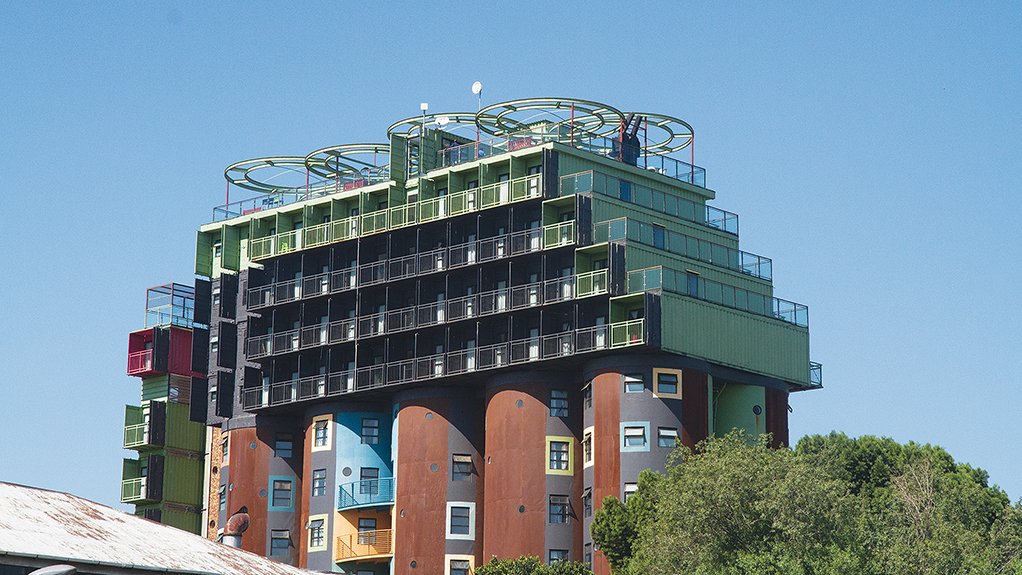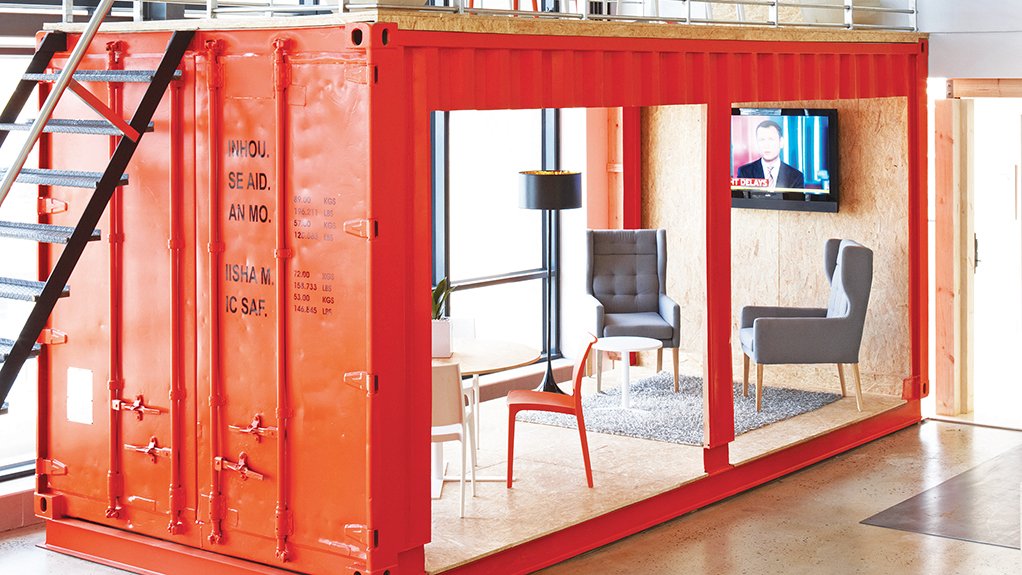Shipping containers capturing the imagination as alternative building blocks





Out of the ordinary Mill Junction provides students with a unique living space in the heart of Newtown
ALTERNATIVE USE Shipping containers are the most wonderfully diverse modular building blocks
CREATIVE CONCEPTS Shipping containers can be used as alternative materials
Demand for shipping containers as an alternative building material has increased across South Africa and the continent, with many companies discovering both uses and a wide variety of creative and socially uplifting applications for them, from student accommodation to libraries.
Container manufacturer Container World operations director Darren Singh tells Engineering News that there is huge market scope for the shipping container industry in Africa.
He says market demand for such alternative uses started in the early 1970s, which is when the company decided it could add value to the containers by transforming them into offices, clinics and apartments.
Even though the current market is depressed, owing to the weakened global and domestic economy, he believes demand may still increase in 2016.
“A big market for us is remote camp site solutions, which are popular with companies that work on remote sites for lengthy periods. We supply liveable containers, equipped with heat regulation and ventilation, to these sites,” Singh says.
Modular Building Blocks
Cape Town-based container housing developer Berman-Kalil Housing cofounder Brad Berman says, after seeing container developments abroad, he decided to investigate the possibilities of this style of building in South Africa.
“Shipping containers are the most wonderfully diverse modular building blocks that modern life has to offer and the potential, particularly in remote parts of Africa, where building is a logistical challenge, is enormous,” he says.
Berman adds that the company has a variety of suppliers of the different shipping containers that the company uses, and the containers vary in size.
“The vast majority of our shipping containers come from shipping group Maersk, which has a large network of depots all over South Africa and abroad, as well as the ability to get the completed products to wherever their final destination may be.”
Local architectural firm Inhouse Brand Architects has also embraced the shipping container as an alternative material. It recently completed the new Cape Town offices of local advertising agency 99c by converting a recycled shipping container into a waiting room.
“Working with shipping containers is more restrictive than designing conventional buildings, as designers are limited to the various sizes and shapes of the containers. Although it can be limiting to work within these parameters, it is easy to modify the container to create the end product,” says Inhouse associate director Moiisha Visagie.
However, a positive aspect of designing for shipping containers is that they are inexpensive, readily available and convenient to adjust.
The converted shipping container for 99c is decorative and functional in its offering: a waiting area, meeting room and casual meeting space.
Berman says building regulations are not as stringent for containers as they are for brick and mortar, as many aspects fall into a ‘legal grey area’.
“We have to scrutinise new or potential products very carefully. Our units are designed to withstand a lot more movement than a traditional home,” he says.
Competitive Pressures
Singh notes that competition from China has been a major industry challenge.
“China manufactures what is called a ‘speedy kit’ – panels made for a container. If you have a container, all you need to do is insulate it. The speedy kit fits inside and has all the fittings you need, including windows and doors, and space for an air conditioner,” Singh notes.
He says China “is hurting” Africa when it comes to the local shipping container industry. Chinese competitors can manufacture the containers much faster than local companies, as they do not have to import the raw materials from which the containers are manufactured. The prices of raw materials are very high for South Africa because most of the materials are imported from China, Singh explains.
A large, highly skilled workforce also enables China to quote at “ridiculously low prices” in Africa, he adds.
“We have a joint venture with a shipping container manufacturer in Shanghai, which has helped us remain competitive in the market. As much as the Chinese hurt us in terms of business, I admire what they are able to do,” Singh notes.
Meanwhile, Berman notes that space and finance have been major challenges for clients.
“People often think of shipping containers as small, dark and dingy spaces. One of the unique challenges has been educating people to realise how much can fit into shipping containers and how beautifully they can be constructed.”
He notes that financial challenges for clients are especially prevalent in the low-cost housing market, where there is a general need for housing, coupled with generally limited funding.
Berman states that containers converted into housing units are not classified under any criteria that qualify as a home loan, which has proven challenging, as banks are not readily willing to offer finance for such housing to the general public.
Local Market Experience
The R30-million mall-meets-market shopping centre, 27Boxes, opened in Melville, Gauteng, in July last year.
The centre was built using 102 shipping containers to accommodate restaurants, coffee shops and about 80 stores selling clothing, décor and art.
Food franchise Prawn Stars owner Dimitri Sikiotis has a container at 27Boxes and says he invested in the shopping centre because the idea of building a shopping mall out of shipping containers is unique to the South African market, with Melville also being a trendy location.
“The location was the attraction. My first perception of the development was just containers stacked next to each other. When I arrived on site and saw the layout, I thought it was amazing,” he says.
He notes that the food franchise opened in June last year and the experience of working out of a shipping container has been good.
“The space is perfect for the volumes that the centre attracts. I have a single container, many other people have double units. I found it difficult to cope with customer volume, owing to the width of the container, but we are managing. Our kitchen operates efficiently.
“We have, unfortunately, seen a decline in people visiting the centre,” he notes, adding that it could be attributed to people spending less in the current economic climate.
Social Impact
Singh says the company wants to create awareness in government that converted shipping containers can be used in the informal sector and as reconstruction and development (RDP) houses.
“It takes three months to build a brick and mortar house; it can take less than three days to put up a shipping container. It is also less labour intensive and more cost efficient,” he explains.
Berman notes that many companies have bought containers from Berman-Kalil as part of their corporate social responsibility (CSR) initiatives, noting that companies and even the general public are becoming more accepting of the idea of building with containers.
“Working with CSR initiatives has enabled us to not only create a specialised branding system but also digitally print any artwork onto custom containers.
“Hopefully, 2016 will be a bigger year for the corporate sector to invest in this type of solution, benefit from this form of marketing and make a difference in the country,” he concludes.
Comments
Press Office
Announcements
What's On
Subscribe to improve your user experience...
Option 1 (equivalent of R125 a month):
Receive a weekly copy of Creamer Media's Engineering News & Mining Weekly magazine
(print copy for those in South Africa and e-magazine for those outside of South Africa)
Receive daily email newsletters
Access to full search results
Access archive of magazine back copies
Access to Projects in Progress
Access to ONE Research Report of your choice in PDF format
Option 2 (equivalent of R375 a month):
All benefits from Option 1
PLUS
Access to Creamer Media's Research Channel Africa for ALL Research Reports, in PDF format, on various industrial and mining sectors
including Electricity; Water; Energy Transition; Hydrogen; Roads, Rail and Ports; Coal; Gold; Platinum; Battery Metals; etc.
Already a subscriber?
Forgotten your password?
Receive weekly copy of Creamer Media's Engineering News & Mining Weekly magazine (print copy for those in South Africa and e-magazine for those outside of South Africa)
➕
Recieve daily email newsletters
➕
Access to full search results
➕
Access archive of magazine back copies
➕
Access to Projects in Progress
➕
Access to ONE Research Report of your choice in PDF format
RESEARCH CHANNEL AFRICA
R4500 (equivalent of R375 a month)
SUBSCRIBEAll benefits from Option 1
➕
Access to Creamer Media's Research Channel Africa for ALL Research Reports on various industrial and mining sectors, in PDF format, including on:
Electricity
➕
Water
➕
Energy Transition
➕
Hydrogen
➕
Roads, Rail and Ports
➕
Coal
➕
Gold
➕
Platinum
➕
Battery Metals
➕
etc.
Receive all benefits from Option 1 or Option 2 delivered to numerous people at your company
➕
Multiple User names and Passwords for simultaneous log-ins
➕
Intranet integration access to all in your organisation




















